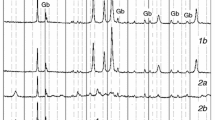Abstract
The thermal decomposition of three structurally and chemically close compounds: Zn4(OH)6(SO4)·4H2O, NaZn4(OH)6(SO4)Cl·6H2O and CaZn8(OH)12(SO4)2Cl2·9H2O, known as namuwite, gordaite and “Ca-gordaite,” was comparatively studied. The thermal events, the released volatiles and solid residues were studied in the range of 20–1000 °C using TG–DTA-MS and powder XRD analyses. The thermal decomposition process of all three compounds includes successive dehydration, dehydroxylation and evolving of SO2, O2 and Cl. The first stage of dehydration occurs in the low-temperature region by the retention of the layered structure with an undisturbed hydroxide layer and a shrunk interlayer. The release of last interlayer water molecules induces the dehydroxylation of the hydroxide layer. As a result, ZnO and a series of secondary hydroxides and hydroxy-salts: Zn3(OH)2(SO4)2 (in the decomposition of the three compounds), β-Zn(OH)Cl (in the case of both gordaites) and Ca(OH)2 (for Ca-gordaite) were formed. The existence and formation of Zn3(OH)2(SO4)2 for the first time were proved by powder XRD. The decomposition of all secondary hydroxyl-containing compounds during the second stage of the dehydroxylation leads to formation of Zn3O(SO4)2, ZnCl2 and CaSO4 at middle temperature region. In the high-temperature region, the evolving of SO2, O2 and HCl occurred due to the decomposition of the (SO4)-groups and ZnCl2 hydration, respectively. At temperatures up to 1000 °C, ZnO was found to be the main final product of the thermal decomposition of the three minerals. In the case of gordaites, an anhydrite and a Na–Zn–SO4 X-ray amorphous phase were also presented.





Similar content being viewed by others
References
Burns PC, Roberts AC, Nikischer AJ. The crystal structure of Ca[Zn8(SO4)2(OH)12Cl2](H2O)9, a new phase from slag dumps at Val Varena, Italy. Eur J Miner. 1998;10:923–30.
Ohnishi M, Kusachi I, Kobayashi S. Osakaite, Zn4 SO4(OH)6·5H2O, a new mineral from the Hirao Mine, Osaka, Japan. Can Mineral. 2007;45:1511–7.
Chukanov NV, Rastsvetaeva RK, Aksenov SM, Pekov IV, Belakovsky DI, Blass G, Möhn G. Lahnsteinite, Zn4(SO4)(OH)6·3H2O, a new mineral from the Friedrichssegen mine Germany. Proc Russ Mineral Soc. 2013;CXLII(1):39–46 (in Russian).
Odnevall I, Leygraf C. Formation of NaZn4(OH)6SO4·6H2O in a marine atmosphere. Corr Sci. 1993;34:1213–29.
Odnevall I, Leygraf C. The formation of Zn4Cl2(OH)4SO4·5H2O in an urban and an industrial atmosphere. Corrosion science. 1994;36:1551–67.
Volovitch P, Allely C, Ogle K. Understanding corrosion via corrosion product characterization: I. Case study of the role of Mg-alloying in Zn–Mg coating on steel. Corros Sci. 2009;51:1251–62.
Santana JJ, Fernandez-Perez BM, Morales J, Vaconcelos HC, Sonto RM, Gonzalez S. Characterization of the corrosion products formed on zinc in archipelagic subtropical environments. Int J Electrohem Sci. 2012;7:2730–41.
Warinner WD, Controy EH. Production of zinc oxysulfate. US Patent 2602727. 1952.
Wesfall DG, Amirini M, Peterson GA. Water solubility of zinc fertilizer: does it matter? Better Crops. 1999;83(2):18–20.
Waitkins GR, Grawford JB. Basic zinc sulfate pigments. US Patent 3136647. 1964.
Hongo T, Lemur TS, Satokawa S, Yamazaki A. Chromate adsorption and pH buffering capacity of zinc hydroxy salts. Appl Clay Sci. 2010;48:455–9.
Groat LA. The crystal structure of namuwite, a mineral with Zn in tetrahedral and octahedral coordination, and its relationship to synthetic basic zinc sulfates. Am Mineral. 1996;81:238–43.
Adiwidjaja G, Frise K, Klaska K-H, Schlüter J. The crystal structure of gordaite NaZn4(SO4)(OH)6Cl·6H2O. Z Kristallogr. 1997;212:704–7.
Hawthorne FC, Schindler M. Topological enumeration of decorated [Cu2+ϕ2]N sheets in hydroxy-hydrated copper oxysalt minerals. Can Mineral. 2000;38:751–61.
Ben’yash EY, Belakhova VI, Vershinina FI, Shokarev MM. On the composition of solid state in the systems ZnSO4–ZnO–H2O and ZnSO4–Na2O–H2O. Russ J Inorg Chem. 1981;26:888–93.
Bear IJ, Gray IE, Madsen IC, Newnham IE, Rogers LJ. Structures of basic zinc sulfates 3Zn(OH)2·ZnSO4·mH2O, m = 3 and 5. Acta Crystallogr B. 1986;42:32–9.
Bear IJ, Gray IE, Newnham IE, Rogers LJ. The ZnSO4·3Zn(OH)2·H2O system. I. Phase formation. Aust J Chem. 1987;40:539–56.
Moezzi A, Cortie MB, McDonagh AM. Zinc hydroxide sulfate and its transformation to crystalline zinc oxide. Dalton Trans. 2013;42:14432–7.
Liang W, Li W, Chen H, Liu H, Zhu L. Exploring electrodeposited flower-like Zn4(OH)6SO4·4H2O nanosheets as precursor for porous ZnO nanosheets. Electrochim Acta. 2015;156:171–8.
He P, Gao HD, Wu LB, Jiang ZW, Wang GL, Li XM. Porous ZnO sheets transformed from zinc sulfate hydroxide hydrate and their photoluminescence performance. Acta Phys Chem Shin. 2013;29:874–80.
Nasdala L, Witzke T, Ullrich B, Brett R. Gordaite [Zn4Na(OH)6(SO4)Cl·6H2O]: second occurrence in the Juan de Fuca Ringe, and new data. Am Mineral. 1988;83:1111–6.
Frost R, Palmer S, Pogson R. Thermal stability of the ‘cave’ mineral ardealite Ca2(HPO4)(SO4)·4H2O. J Therm Anal Calorim. 2012;107(2):549–53.
Frost R, Palmer S, Pogson R. Thermal stability of crandallite CaAl3(PO4)2(OH)5·(H2O). J Therm Anal Calorim. 2012;107(3):905–9.
Pasierb P, Gajerski R, Osiadły M, Łącz A. Application of DTA-TG-MS for determination of chemical stability of BaCeO3 − δ-based protonic conductors. J Therm Anal Calorim. 2014;117:683–91.
Chang J, Fang Y. Quantitative analysis of accelerated carbonation products of the synthetic calcium silicate hydrate(C–S–H) by QXRD and TG/MS. J Therm Anal Calorim. 2015;119:57–62.
Fleet M, Knipe S. Structure of magnesium hydroxide sulfate (2(MgSO4)·(Mg(OH)2)) and solid solution in magnesium hydroxide sulfate hydrate and caminite. Acta Crystallogr B. 1997;53:358–63.
Garcia-Martinez O, Vila E, Martin de Vidales JL, Rojas RM, Petrov K. On the thermal decomposition of the zinc (II) hydroxide chlorides Zn5(OH)8Cl2·H2O and β-Zn(OH)Cl. J Mater Sci. 1994;29:5429–34.
Kozawa T, Onda A, Yanagisawa K, Kishi A, Masuda Y. Effect of water vapor on thermal decomposition process of zinc hydroxide and crystal growth of zinc oxide. J Solid State Chem. 2011;184:589–96.
Srivastava OK, Secco EA. Studies on metal hydroxy compounds. I. Thermal analyses of zinc derivatives ε-Zn(OH)2, Zn5(OH)8C12·H2O, β-ZnOHC1, and ZnOHF. Can J Chem. 1967;45:579–83.
Author information
Authors and Affiliations
Corresponding author
Rights and permissions
About this article
Cite this article
Staminirova, T., Petrova, N. & Kirov, G. Thermal decomposition of zinc hydroxy-sulfate-hydrate minerals. J Therm Anal Calorim 125, 85–96 (2016). https://doi.org/10.1007/s10973-016-5325-x
Received:
Accepted:
Published:
Issue Date:
DOI: https://doi.org/10.1007/s10973-016-5325-x




